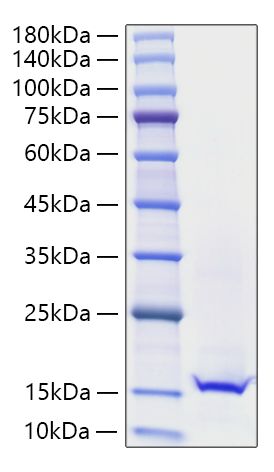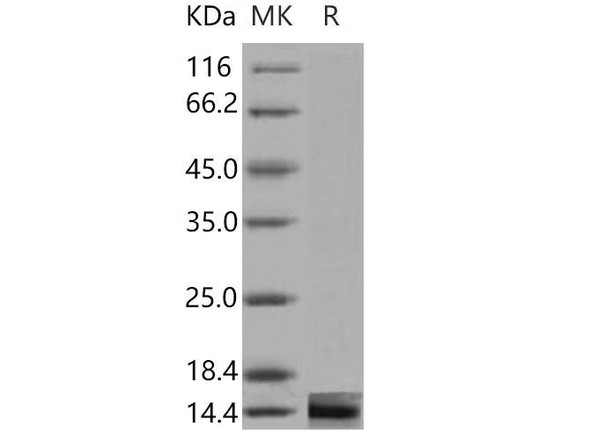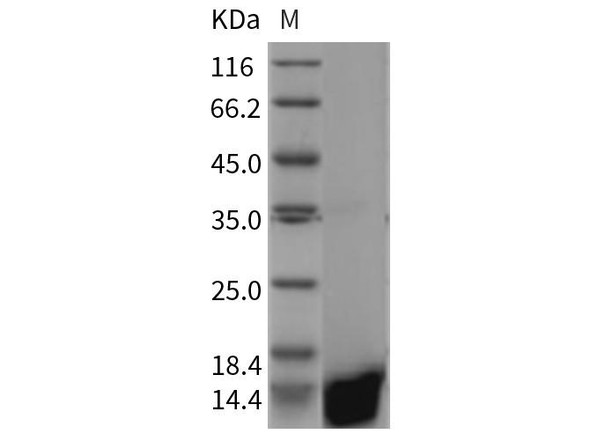Description
Recombinant Mouse Galectin-1/LGALS1 Protein
The Recombinant Mouse Galectin-1/LGALS1 Protein is a high-quality recombinant protein designed for murine biological research applications. This protein serves as an essential reagent in mouse model studies, comparative immunology research, and preclinical therapeutic evaluations, enabling scientists to investigate Galectin-1/LGALS1 biology and its relevance to human disease mechanisms through translational research approaches.
This product (SKU: RPCB1869) is produced using advanced expression systems and features a NO-tag tag for convenient detection and purification. The protein exhibits a calculated molecular weight of 14.66 kDa with an observed molecular weight of 15-20 kDa under denaturing conditions, achieving ≥ 95% as determined by SDS-PAGE.. Functional bioactivity has been validated through rigorous quality control assays, confirming its suitability for demanding research applications.
Key Features
| High Purity by Affinity Chromatography | |
| Mammalian & Bacterial Expression Systems | |
| High lot-to-lot consistency via strict QC |
| Product Name: | Recombinant Mouse Galectin-1/LGALS1 Protein |
| SKU: | RPCB1869 |
| Size: | 10 μg , 20 μg , 50 μg , 100 μg |
| Reactivity: | Mouse |
| Synonyms: | Galectin-1, Gal-1, 14 kDa lectin, Beta-galactoside-binding lectin L-14-I, Galaptin, Lactose-binding lectin 1, Lectin galactoside-binding soluble 1, S-Lac lectin 1, Lgals1, Gbp |
| Tag: | NO-tag |
| Calculated MW: | 14.66 kDa |
| Observed MW: | 15-20 kDa |
| Gene ID: | 16852 |
| Protein Description: | High quality, high purity and low endotoxin recombinant Recombinant Mouse Galectin-1/LGALS1 Protein (RPCB1869), tested reactivity in E. coli and has been validated in SDS-PAGE.100% guaranteed. |
| Endotoxin: | < 1 EU/μg of the protein by LAL method. |
| Purity: | ≥ 95% as determined by SDS-PAGE. |
| Formulation: | Lyophilized from a 0.22 μm filtered solution of PBS,1mM DTT,1mM EDTA,pH7.4. |
| Bio-Activity: | Measured by its ability to agglutinate mouse red blood cells. The ED 50 for this effect is 6.25-12.5 μg/mL. |
| Reconstitution: | Centrifuge the vial before opening. Reconstitute to a concentration of 0.1-0.5 mg/mL in sterile distilled water. Avoid vortex or vigorously pipetting the protein. For long term storage, it is recommended to add a carrier protein or stablizer (e.g. 0.1% BSA, 5% HSA, 10% FBS or 5% Trehalose), and aliquot the reconstituted protein solution to minimize free-thaw cycles. |
| Storage: | Store at -20℃.Store the lyophilized protein at -20℃ to -80 ℃ up to 1 year from the date of receipt. After reconstitution, the protein solution is stable at -20℃ for 3 months, at 2-8℃ for up to 1 week. |
Galectin-1 (Gal-1, GAL1), is a member of the galectins, a family of animal lectins ranging from Caenorhabditis elegans to humans, which is defined by their affinity for beta-galactosides and by significant sequence similarity in the carbohydrate-binding site. It is a homodimer with a subunit molecular mass of 14.5 kDa, which contains six cysteine residues per subunit. The cysteine residues should be in a free state to maintain a molecular structure that is capable of showing lectin activity. This endogenous lectin widely expressed at sites of inflammation and tumor growth has been postulated as an attractive immunosuppressive agent to restore immune cell tolerance and homeostasis in autoimmune and inflammatory settings. On the other hand, galectin-1 contributes to different steps of tumor progression including cell adhesion, migration, and tumor-immune escape, suggesting that blockade of galectin-1 might result in therapeutic benefits in cancer. Several potential glycoprotein ligands for galectin-1 have been identified, including lysosome-associated membrane glycoproteins and fibronectin, laminin, as well as T-cell glycoproteins CD43 and CD45. Evidence points to Gal-1 and its ligands as one of the master regulators of such immune responses as T-cell homeostasis and survival, T-cell immune disorders, inflammation, and allergies as well as host-pathogen interactions.







